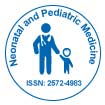Congenital: Understanding Conditions Present from Birth
Received: 03-Feb-2025 / Manuscript No. nnp-25-171022 / Editor assigned: 06-Feb-2025 / PreQC No. nnp-25-171022 / Reviewed: 18-Feb-2025 / QC No. nnp-25-171022 / Revised: 22-Feb-2025 / Manuscript No. nnp-25-171022 / Published Date: 28-Feb-2025 DOI: 10.4172/2572-4983.1000507
Introduction
The term “congenital” refers to conditions, disorders, or traits that are present at birth. These conditions may be caused by genetic factors, environmental influences during pregnancy, or a combination of both. Congenital disorders can affect any part of the body, including the heart, brain, limbs, or internal organs, and can range from mild to severe in their impact on health and development. Understanding congenital conditions is vital for early detection, proper management, and improving the quality of life for affected individuals [1], [2].
Discussion
Congenital conditions can be broadly classified into structural and functional types. Structural congenital disorders involve physical abnormalities such as cleft lip and palate, congenital heart defects, spina bifida, and limb deformities. Functional or metabolic disorders, on the other hand, affect the way the body works and include conditions like congenital hypothyroidism, cystic fibrosis, and sickle cell anemia. The causes of congenital disorders are diverse and often multifactorial. Genetic mutations, chromosomal abnormalities, or inherited traits can lead to congenital disorders, while environmental factors such as maternal infections, exposure to harmful substances, poor nutrition, or certain medications during pregnancy may also contribute [3], [4].
Early detection of congenital conditions is critical for effective management. Prenatal screening, including ultrasound scans, blood tests, and genetic testing, allows for the identification of many conditions before birth. In some cases, timely interventions such as fetal surgery or medical therapy can improve outcomes. After birth, newborn screening programs play a key role in diagnosing congenital metabolic and genetic disorders, enabling early treatment that can prevent complications and support normal development [5], [6].
Management of congenital disorders varies depending on the type and severity of the condition. Some structural abnormalities may require surgical correction, while functional or metabolic disorders often need lifelong medical care, dietary adjustments, or medications. Supportive therapies such as physical therapy, occupational therapy, and counseling can also enhance the quality of life and promote independence for individuals affected by congenital conditions [7], [8].
Prevention strategies focus primarily on reducing risk factors before and during pregnancy. Genetic counseling is recommended for couples with a family history of congenital disorders to assess the likelihood of inheritance. Ensuring proper maternal nutrition, avoiding harmful substances such as alcohol and tobacco, managing chronic health conditions, and adhering to recommended prenatal care guidelines can all help reduce the risk of congenital disorders. Public awareness campaigns and healthcare support systems further contribute to prevention and early intervention [9], [10].
Conclusion
Congenital conditions are an important aspect of human health, encompassing a wide range of structural and functional disorders present at birth. Understanding their causes, early detection methods, and management options is essential to improving outcomes and supporting affected individuals. While not all congenital disorders can be prevented, proactive healthcare measures, prenatal care, and genetic counseling can significantly reduce risks and enable timely interventions. By fostering awareness and providing appropriate medical and social support, society can help individuals with congenital conditions lead healthier and more fulfilling lives.
References
- Shilpi M, Kumar K S, Kumar D (2020) Ayurvedic Approach Of Treatment Of Recurrent/ Chronic Cough In Children With Special Reference To Pancha Vidha Kasa. Ind J of App Res 10: 51-52.
- Nelaturi P, Nagarajan P, Sabapathy SK, Sambandam R (2021) Swarna Bindu Prashana—an Ancient Approach to Improve the Infant’s Immunity. Bio Tra Ele Res 199: 2145-2148.
- Sonune VG, Bhagile JB (2021) Use of Swarna Bindu Prashan in Children. IJRAMT 2: 215-217.
- Dutt SB, Jayant N (2016) A review article on Swarna prashana samskara wsr immunization. IJAA 2: 1024-1028.
- Shahapure S (2018) A Study On Parent’s Opinion Towards Swarna Bindu Prashana In Kalaburagi City. IJPERA 3: 1-4.
- Rao NP, Shailaja U, Mallika KJ, Desai SS, Debnath P (2012) Traditional Use Of Swarnamrita Prashana As A Preventive Measure: Evidence Based Observational Study In Children. IJRiAP 3: 1-5.
- Aniket P, Pallavi D, Aziz A, Avinash K, Vikas S (2017) Clinical effect of suvarna bindu prashan. JAIMS 2: 11-18.
- Gaikwad A (2011) A Comparative pharmaco-clinical study of Madhu-Ghrita and SwarnaVacha Madhu-Ghrita on neonates. Ayurved MD Research thesis. Jamnagar IPG T and R. A Gujarat Ayurveda University.
- Singh (2016) A Randomized Controlled Clinical Trial on Swarna Prashana and its Immunomodulatory Activity in Neonates. Jamnagar
- Rathi R, Rathi B (2017) Efficacy of Suvarnaprashan in Preterm infants-A Comparative Pilot study Journal of Indian System of Medicine 5: 91.
Citation: Elif Y (2025) Congenital: Understanding Conditions Present from Birth. Neonat Pediatr Med 11: 507. DOI: 10.4172/2572-4983.1000507
Copyright: © 2025 Elif Y. This is an open-access article distributed under the terms of the Creative Commons Attribution License, which permits unrestricted use, distribution, and reproduction in any medium, provided the original author and source are credited.
Select your language of interest to view the total content in your interested language
Share This Article
Recommended Journals
Open Access Journals
Article Tools
Article Usage
- Total views: 240
- [From(publication date): 0-0 - Dec 09, 2025]
- Breakdown by view type
- HTML page views: 181
- PDF downloads: 59
